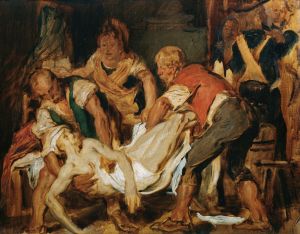
Der Salamander
A hand-painted replica of Hans Canon’s masterpiece Der Salamander, meticulously crafted by professional artists to capture the true essence of the original. Each piece is created with museum-quality canvas and rare mineral pigments, carefully painted by experienced artists with delicate brushstrokes and rich, layered colors to perfectly recreate the texture of the original artwork. Unlike machine-printed reproductions, this hand-painted version brings the painting to life, infused with the artist’s emotions and skill in every stroke. Whether for personal collection or home decoration, it instantly elevates the artistic atmosphere of any space.
Hans Canon, born Johann Baptist Strašiřipka, was an Austrian painter known for his historical and allegorical works. One of his notable paintings is "Der Salamander," which translates to "The Salamander." This painting is a fine example of Canon's skill in combining mythological themes with a vivid and dynamic style.
"Der Salamander" was created in the late 19th century, a period when Canon was actively producing some of his most significant works. The painting depicts a scene involving a salamander, a creature often associated with fire in mythology and alchemy. In various traditions, salamanders were believed to be able to live in fire and were sometimes seen as symbols of transformation and resilience.
Hans Canon's "Der Salamander" showcases his ability to blend realism with fantastical elements. The painting is characterized by its rich color palette and intricate details, which bring the mythical creature to life. Canon's use of light and shadow adds depth to the composition, highlighting the salamander's fiery environment and emphasizing its mythical qualities.
The painting reflects Canon's interest in combining naturalistic detail with imaginative subjects. This approach was typical of the Symbolist movement, which sought to express ideas and emotions through symbolic imagery. Canon's work often explored themes of mythology, history, and allegory, making "Der Salamander" a fitting example of his artistic vision.
Hans Canon was a prominent figure in the Austrian art scene during his lifetime. He studied at the Academy of Fine Arts in Vienna and later traveled extensively, which influenced his artistic development. Canon's works were well-received, and he gained recognition for his contributions to the arts. His ability to capture both the physical and metaphysical aspects of his subjects made his paintings stand out.
"Der Salamander" remains an important piece in Canon's oeuvre, illustrating his mastery of both technique and thematic exploration. The painting is housed in a collection that showcases Canon's diverse body of work, reflecting his significant role in 19th-century Austrian art.
In summary, Hans Canon's "Der Salamander" is a notable example of his ability to merge mythological themes with a realistic style. The painting's rich detail, dynamic composition, and symbolic content exemplify Canon's artistic strengths and his contribution to the Symbolist movement.


















